ASUS PQ321Q UltraHD Monitor Review: Living with a 31.5-inch 4K Desktop Display
by Chris Heinonen on July 23, 2013 9:01 AM ESTUniformity is tested by using 25 locations across the screen and measuring the color checker chart at each of them. From there we can pull out contrast, black and white uniformity, and color uniformity. This review is the first to utilize the newest measurement available in CalMAN 5.1.2: dE From Center. Now instead of measuring the dE2000 at every location, we measure it relative to the center measurement.
This gives us a true uniformity measure. I could measure the left side and the right side of the monitor and get a dE2000 of 2.0 for each side. What that doesn’t tell me is that the left side might be red tinted, and the right side blue tinted, while the center might be green tinted. In this case they could all measure the same dE2000, but look totally different. By comparing the measured values to the center, we get an actual measurement of if one area of the screen will look the same as another area. Since we always use the center of the screen as our calibration target, which is why everything is measured relative to that.
Starting out with White Uniformity, we see decent but not amazing results. The panel stays within +/- 10% for the center, but falls down to a 17% variation at the edges. The light fall-off is relatively high, and makes me wonder if the look of the panel, and its thin design, might place a bit of emphasis on style over substance.
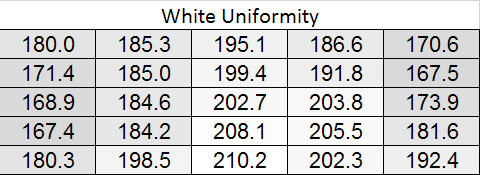

With the black level charts we see similar results. The middle of the panel is +/- 10% again, but the edges fall off to a nearly 20% difference. There is a curious rise in black level in one measure where there was a fall-off in white level, but otherwise the results between the two measurements are similar.
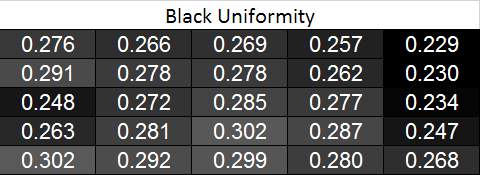
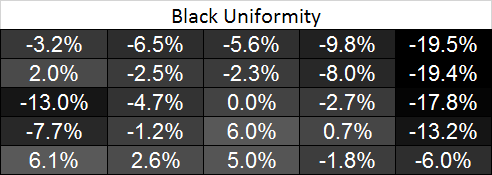
Looking at the resulting contrast, the numbers here are much closer to 100%, which we expect to see. Areas with light fall-off affect the white and black levels almost equally, so the contrast ratios are very similar all across the screen. That gives us a 700:1 expected contrast ratio for the screen as a whole.
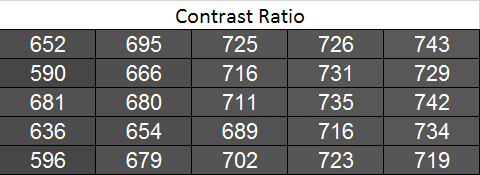
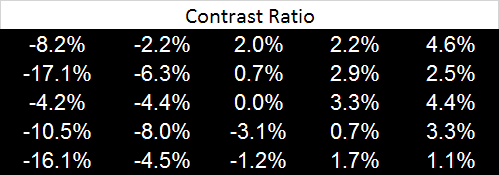
Now we can see the new dE2000 From Center data. The issues here crop up at the outsides of the screen, where we see the backlighting issues earlier. Uneven lighting is the issue most likely to cause color issues on the screen, and that is certainly backed up here. In the center of the screen, you are going to not see a difference in colors when you look directly at the screen. With a light loss of less than 10%, and a color dE2000 of <2 for most of the center screen, everything will look identical. As you get to the extreme edges you will run into more issues. I will need more monitors to be tested with this new method, but I think this is going to wind up as a good result in the end.

Going with an LED lighting system, and not a backlit array one, is always a bit of a concern for me. Overall the PQ321Q does well for uniformity for using one, and it avoids some of the massive issues we have seen with some LED systems before. But we are looking for near-perfection from the ASUS and it can’t quite do that. The center 60% of the screen is excellent overall, and for most people that will mean you may not notice these issues at all, but they are there.










166 Comments
View All Comments
cheinonen - Tuesday, July 23, 2013 - link
And then after that you're going to sell far fewer, so your profit margins are going to have to change to adapt for that as well, and it really winds up making them far more expensive. It really is the best looking display I've used and the one I most want to keep around after the review period. Companies should be rewarded for taking the risk in releasing niche products that help push the market forward, and really are a breakthrough.Sivar - Tuesday, July 23, 2013 - link
Ideally they can cut 3 good 15" displays from the failed 30" material.Whether the process actually works this way, I don't know.
madmilk - Tuesday, July 23, 2013 - link
It doesn't work that way. That's like saying Intel can cut a quad core CPU into two dual core CPUs.sunflowerfly - Wednesday, July 24, 2013 - link
Where do you think Intel gets lower core count CPU's? They actually do disable cores and sell them for lower spec parts.DanNeely - Thursday, July 25, 2013 - link
They've done so in the past, and IIRC still do bin GPU levels that way; but in all their recent generations the dual and quad core CPUs that make up 99% of their sales have been separate dies.Your analogy breaks down even for the handful of exceptions (single core celeron, quadcore LGA2011); since the LCD equivalent would be to sell you a 15" screen in a 30" case with a huge asymmetric bezel covering 3/4ths of the panel area.
Calista - Thursday, July 25, 2013 - link
It's not just the parts getting more expensive to manufacture, it's also because the manufacturer knows it's a high-margin product. The difference in price for an APS-C vs an FF sensor is on the order of a magnitude smaller than the difference in price between the complete cameras, i.e. $500 vs $2500, even if the FF camera obviously also include faster processing, higher quality body etc.YazX_ - Tuesday, July 23, 2013 - link
companies would like like to milk users as its brought to Desktop marketed as NEW TECH, this is the only reason why its very pricey, and dont forget that on the next months other companies will bring their products into competition which will help greatly in reduce the prices.Fleeb - Tuesday, July 23, 2013 - link
This reply is better than yours: http://www.anandtech.com/comments/7157/asus-pq321q...madmilk - Tuesday, July 23, 2013 - link
No worries, there's a 4K 39" TV on Amazon for $700. Since that TV has the same number of pixels and isn't a whole lot bigger, I think we will soon be seeing these 32" displays fall into that sub-$1000 range as well.peterfares - Wednesday, July 24, 2013 - link
That screen is lower quality and doesn't have an input capable of driving it at 60Hz at 4K